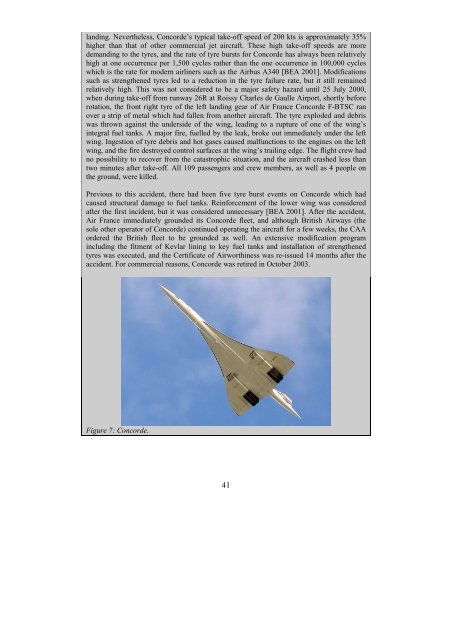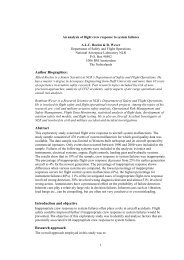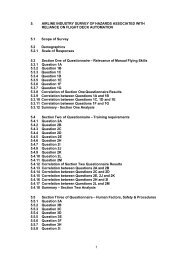Causal risk models of air transport - NLR-ATSI
Causal risk models of air transport - NLR-ATSI
Causal risk models of air transport - NLR-ATSI
You also want an ePaper? Increase the reach of your titles
YUMPU automatically turns print PDFs into web optimized ePapers that Google loves.
landing. Nevertheless, Concorde’s typical take-<strong>of</strong>f speed <strong>of</strong> 200 kts is approximately 35%<br />
higher than that <strong>of</strong> other commercial jet <strong>air</strong>craft. These high take-<strong>of</strong>f speeds are more<br />
demanding to the tyres, and the rate <strong>of</strong> tyre bursts for Concorde has always been relatively<br />
high at one occurrence per 1,500 cycles rather than the one occurrence in 100,000 cycles<br />
which is the rate for modern <strong>air</strong>liners such as the Airbus A340 [BEA 2001]. Modifications<br />
such as strengthened tyres led to a reduction in the tyre failure rate, but it still remained<br />
relatively high. This was not considered to be a major safety hazard until 25 July 2000,<br />
when during take-<strong>of</strong>f from runway 26R at Roissy Charles de Gaulle Airport, shortly before<br />
rotation, the front right tyre <strong>of</strong> the left landing gear <strong>of</strong> Air France Concorde F-BTSC ran<br />
over a strip <strong>of</strong> metal which had fallen from another <strong>air</strong>craft. The tyre exploded and debris<br />
was thrown against the underside <strong>of</strong> the wing, leading to a rupture <strong>of</strong> one <strong>of</strong> the wing’s<br />
integral fuel tanks. A major fire, fuelled by the leak, broke out immediately under the left<br />
wing. Ingestion <strong>of</strong> tyre debris and hot gases caused malfunctions to the engines on the left<br />
wing, and the fire destroyed control surfaces at the wing’s trailing edge. The flight crew had<br />
no possibility to recover from the catastrophic situation, and the <strong>air</strong>craft crashed less than<br />
two minutes after take-<strong>of</strong>f. All 109 passengers and crew members, as well as 4 people on<br />
the ground, were killed.<br />
Previous to this accident, there had been five tyre burst events on Concorde which had<br />
caused structural damage to fuel tanks. Reinforcement <strong>of</strong> the lower wing was considered<br />
after the first incident, but it was considered unnecessary [BEA 2001]. After the accident,<br />
Air France immediately grounded its Concorde fleet, and although British Airways (the<br />
sole other operator <strong>of</strong> Concorde) continued operating the <strong>air</strong>craft for a few weeks, the CAA<br />
ordered the British fleet to be grounded as well. An extensive modification program<br />
including the fitment <strong>of</strong> Kevlar lining to key fuel tanks and installation <strong>of</strong> strengthened<br />
tyres was executed, and the Certificate <strong>of</strong> Airworthiness was re-issued 14 months after the<br />
accident. For commercial reasons, Concorde was retired in October 2003.<br />
Figure 7: Concorde.<br />
41




